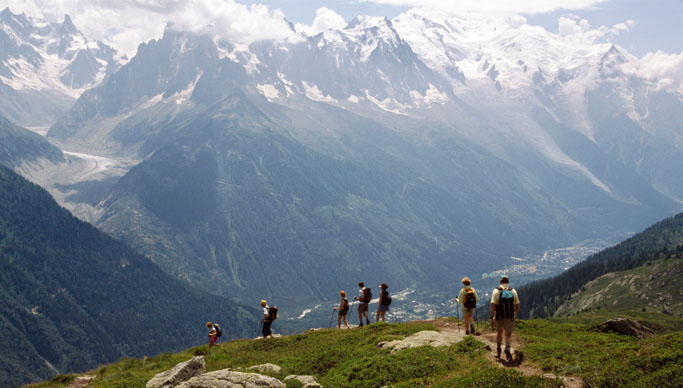You will begin your journey in the Haute Savoie. The Mont Blanc region has always been the center of the Savoie up until the First World War. The geopolitical boundaries of the Savoie have migrated continually since the Romans “civilized” it approximately two thousand years ago. Originally Sapaudia, anthropologists can trace hominid inhabitation here back 70,000 years.
History of the Savoie
In its “modern” context the Savoie was the domain of the House of Savoy. This, the oldest ruling house in Europe, was founded around 1000 by Humbert the Whitehanded. It was developed by the Dukes of Savoy and was made a sovereign state between the Kingdom of France and the Holy Roman Empire. In the early 1800’s the Dukes were clever enough to establish themselves as the Kings of Sardinia at which point the Savoie became a province of the Sardinian States.
The Savoie has always had a colorful history. One such example is a brief occupation by the Burgundians who, occupants of what now is western Switzerland, were chased over the high country into Savoie by the Huns in the latter 5th century. Described, thus, “the Burgundians are brave soldiers and good, but heavy and course people; they consume a lot of garlic and smell mighty since they are in the habit of greasing their hair with rancid butter”. Better them.
The Savoie in the French Revolution
A frequent target of invasion by France, the Savoie was finally annexed by France during the French Revolution. The region was subsequently returned to Sardinia. The Dukes of Savoy, always looking out for a good career move, became the Kings of Italy in 1860 and the Savoie was given to France once and for all. Approved by plebiscite by the Savoyards, the transfer emerged as two French departments: the Savoie and Haute-Savoie.
The departmental seat of the Haute-Savoie is Annecy but modern mountain lovers will always focus on Mont Blanc and its satellite towns and villages as the heart of the country. Chamonix, Courmayeur and to a lesser extent, but representing Switzerland, Martigny are the towns that define the borders of the higher reaches of the Haute-Savoie.
Mont Blanc
The matriarch of the region is Mont Blanc. At 4808 meters the peak is significantly higher than any other in Western Europe, dwarfing the Monte Rosa by nearly 700 ft.. This majesty, combined with an apparently reasonable variety of access opportunities, has made it the focal point of alpinists’ aspirations since the first arrival of alpine “tourists” in the early 1700’s up until the present day.
Race to the Summit
Simply put, everyone wanted to see someone on top of the peak in the 18th Century. The first and many subsequent expeditions hid their inner intentions and declared their efforts in the name of science. Finally, in 1760 all this pretext was shed. While monks and other earlier denizens of this region surely climbed cliffs and peaks for numerous reasons, the creation of Alpinism is attributed to the Genevan Naturalist, Horace Benedict de Saussure. A large reward was offered to anyone who could find a way up Mont Blanc. Jacques Balmat, the local crystal hunter, rose to the challenge 26 years later. Saussure himself achieved the feat the following year, 1787, with no less than 18 guides. The first female ascent came shortly after (in retrospect) in 1808 when Chamonix local Marie Paradis stood on the summit.
The Val d’Aosta
The Val d’Aosta is on the south and most impressive side of Mont Blanc. Paradise is the name given to this national park in northwestern Italy. Created by the Dukes of Aosta as a hunting preserve, the peaks and valleys south of the fascinating Val D’Aosta have retained much of their original character. Unspoiled tracts of mountain wilderness are today home to large herds of chamois and ibex, the big horned mountain goats of the Alps. These majestic creatures are often seen as you traverse the region. The valleys and villages are quiet bastions of mountain culture– a mix of French Savoyard, Roman and Celtic influences. The main valley of Aosta is a fascinating textbook of the region’s history, studded with castles and fortresses that reflect the valley’s importance through the ages.
Cuisine
Cuisine in the Val d’Aosta reflects the Italian and Savoyard influences. In addition to pasta, pizzas and other Italian inspired food, local cuisine relies heavily on a traditional alpine fare, including cheese and potato dishes. Today, local chefs blend these traditions with a lighter, more modern sensibility. The many fine wines of northern Italy and France can be found in the cellars.
The Valais
Your finish, the Valais to the French speaker, or Wallis to the German speaker, is an arid canton with many of Europe’s highest, glaciated peaks. Typically, the weather is sunny and dry, making a hiker’s paradise. Numerous trails follow ancient bisses, or handbuilt irrigation channels, that cross the hillsides and link farming hamlets and high pastures, or alps, and carry the hiker back in time. Other routes climb to high passes on ancient trade routes, some dating to Roman times.









Comments are closed.